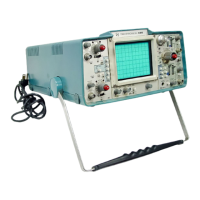Operating Instructions—455/A2/B2
37
A TRIGGER LEVEL—Selects the amplitude point on
the trigger signal at which the sweep is triggered. It is
usually adjusted for the desired display after trigger
SOURCE, COUPLING, and SLOPE have been selected.
38
SOURCE—Determines the source of the trigger signal
coupled to the input of the trigger circuit.
39
COUPLING—Determines the method used to couple
signals to the trigger generator circuit.
AC: Signals are capacitively coupled to the input
of the trigger generator. Dc is rejected and signals
below about 60 Hz are attenuated.
NORM: The trigger signal is obtained from the
signal(s) displayed on the crt. Does not show the
time-relationship of the channel 1 and channel 2
signals in the alternate vertical mode. The NORM
setting is not recommended for use with the
CHOPPED vertical mode because the display
triggers on the switching transients.
CH 1: A sample of the signal present in the chan
nel 1 preamplifier is used as a trigger signal. The
channel 2 display can be unstable if it is not time-
related to the channel 1 signal.
LF REJ: Signals are capacitively coupled to the
input of the trigger circuit. Dc is rejected and sig
nals below about 50 kHz are attenuated. It is use
ful for providing a stable display of the high-frequen
cy components of a complex waveform.
HF REJ: Signals are capacitively coupled to the
input of the trigger circuit. Dc is rejected and sig
nals below about 60 Hz and above 50 kHz are
attenuated. It is useful for providing a stable dis
play of the low-frequency components of a com
plex waveform.
CH 2: A sample of the signal present in the chan
nel 2 preamplifier is used as a trigger signal. The
channel 1 display can be unstable if it is not time-
related to the channel 2 signal.
LINE (A Trigger circuit only): A sample of the
power-line frequency is used as a trigger signal. It
is useful when the input signal is time-related (mul
tiple or sub-multiple) to the line frequency or when
it is desirable to provide a stable display of a line-
frequency component in a complex waveform.
DC: All components of a trigger signal are coupled
to the input of the trigger circuit. It is useful for
providing a stable display of low-frequency or low-
repetition rate signals.
40
POWER—Turns instrument power on (out) and off
(in).
EXT: Signals connected to the External Trigger
Input connectors are used for triggering. External
trigger signals must be time-related to the displayed
signal for a stable display. It is useful when the in
ternal signal is too small or contains undesired
signals that could cause unstable triggering. It is
also useful when operating in the chopped mode.
EXT -f- 10 (A Trigger circuit only): External trig
ger signal attenuated by a factor of 10.
STARTS AFTER DELAY (B Trigger circuit only):
B sweep runs immediately after the delay time se
lected by the A TIM E/DIV switch and the DELAY
TIME POS control. No B trigger is required. In any
other B SOURCE switch position, a trigger is re
quired after the delay time before B sweep will run.
41
A and B TIM E/D IV-The A TIME/DIV switch (clear
plastic skirt) selects the sweep rate for the A sweep
generator circuit and selects the basic delay time for
delayed sweep operation. Multiply the A TIM E/DIV
switch setting by the DELAY TIME POS control to
compute the delay time. The VAR control must be
in the detent position for calibrated A sweep rate and
delay times.
The B TIM E/DIV switch (grey knob, pull out and turn
to unlock) selects the B sweep rate for delayed sweep
operation.
When A TIM E/DIV switch is fully counterclockwise
(X-Y position), horizontal deflection is provided by
the signal connected to the vertical CH 1 input
connector.
REV. A. OCT 1975
2-7

